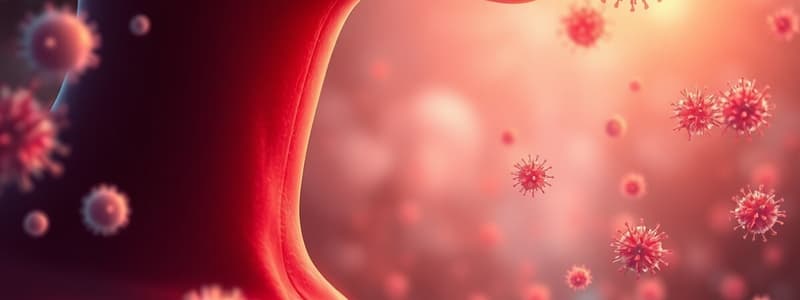Podcast
Questions and Answers
A patient is diagnosed with an infection caused by Eikenella corrodens. Based on the typical distribution of respiratory tract flora, where is this infection most likely located?
A patient is diagnosed with an infection caused by Eikenella corrodens. Based on the typical distribution of respiratory tract flora, where is this infection most likely located?
- Nasopharynx
- Nose
- Pharynx
- Oral cavity/Upper respiratory tract (correct)
A researcher is studying the microbial composition of the nasopharynx. Which genera would be most expected to be found in their samples?
A researcher is studying the microbial composition of the nasopharynx. Which genera would be most expected to be found in their samples?
- Acinetobacter (correct)
- Kingella
- Streptococcus
- Staphylococcus
Following a case of pharyngitis, a patient develops a secondary infection. Cultures reveal the presence of Candida albicans. Which of the following best explains this finding, considering the normal respiratory flora?
Following a case of pharyngitis, a patient develops a secondary infection. Cultures reveal the presence of Candida albicans. Which of the following best explains this finding, considering the normal respiratory flora?
- The patient likely contracted _Candida albicans_ from an external source unrelated to the initial pharyngitis.
- The pharyngitis created an environment that allowed _Candida albicans_, normally present in low numbers, to proliferate. (correct)
- _Candida albicans_ is an opportunistic pathogen; its presence indicates a compromised immune system but is unexpected in the pharynx.
- A primary viral infection predisposed the patient to a fungal infection. The pharynx is the expected location.
A microbiologist is tasked with identifying a bacterial species isolated from the upper respiratory tract. Initial tests suggest it belongs to the Kingella genus or Peptococcus genus. Further testing should focus on differentiating characteristics, considering:
A microbiologist is tasked with identifying a bacterial species isolated from the upper respiratory tract. Initial tests suggest it belongs to the Kingella genus or Peptococcus genus. Further testing should focus on differentiating characteristics, considering:
A patient presents with a nasal infection, and lab results indicate the presence of Staphylococcus aureus. However, the infection is unusually persistent and resistant to common treatments. Which additional bacterial species, if also present, might contribute to this increased virulence and resistance?
A patient presents with a nasal infection, and lab results indicate the presence of Staphylococcus aureus. However, the infection is unusually persistent and resistant to common treatments. Which additional bacterial species, if also present, might contribute to this increased virulence and resistance?
Flashcards
Staphylococcus aureus
Staphylococcus aureus
Inhabits the nose.
Acinetobacter species
Acinetobacter species
Commonly found in the nasopharynx.
Candida albicans
Candida albicans
A flora commonly found in the pharynx.
Kingella species
Kingella species
Signup and view all the flashcards
Streptococcus pyogenes
Streptococcus pyogenes
Signup and view all the flashcards
Study Notes
- Normal flora inhabit the oral cavity and upper respiratory tract
- Bordetella parapertussis and Eikenella corrodens are generally distributed within the respiratory tract.
- The nose contains Cardiobacterium species and Staphylococcus aureus.
- The nasopharynx hosts Acinetobacter species, Campylobacter sputorum, and Hemophilus species.
- Candida albicans, Hemophilus parainfluenzae, and Hemophilus paraphrophilus are found in the pharynx.
- The upper respiratory tract includes Kingella species, Peptococcus species, and Streptococcus pyogenes.
Studying That Suits You
Use AI to generate personalized quizzes and flashcards to suit your learning preferences.



